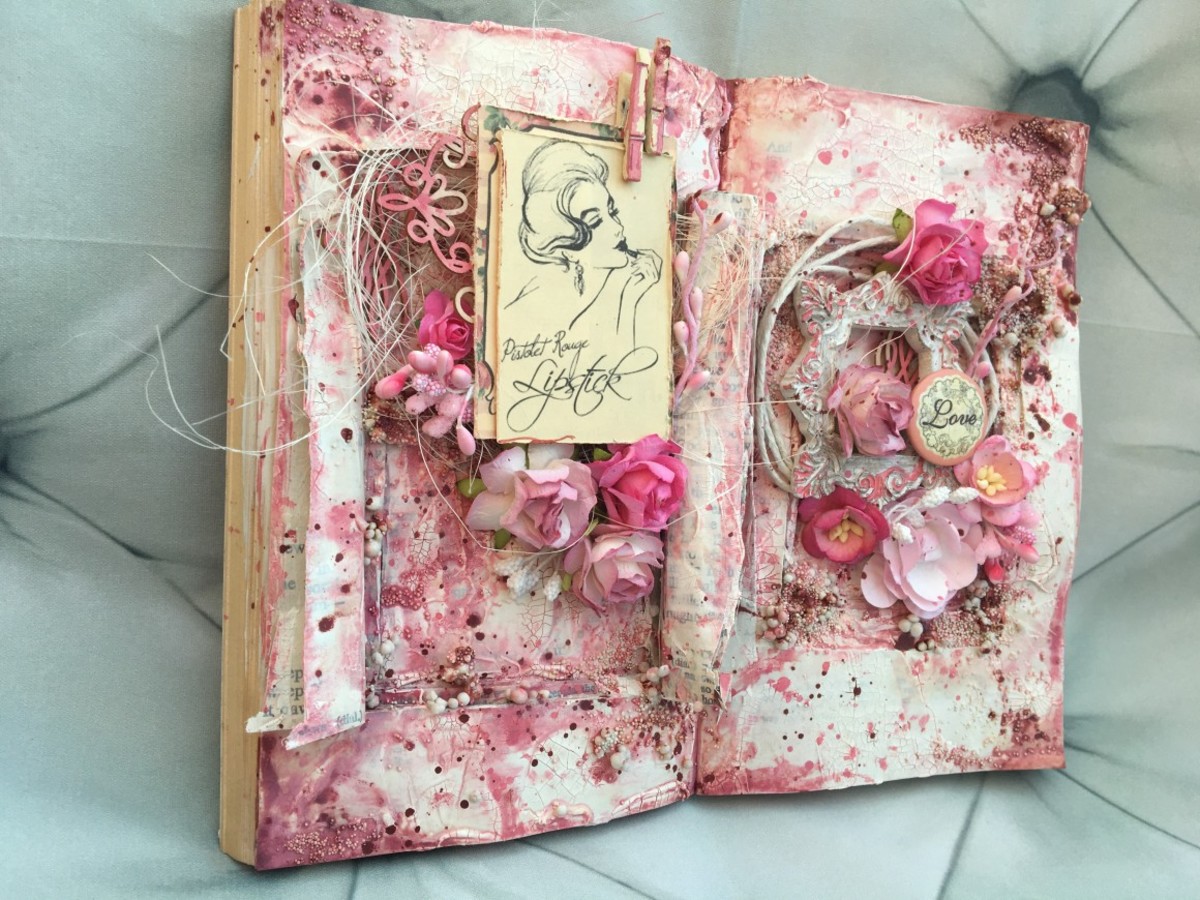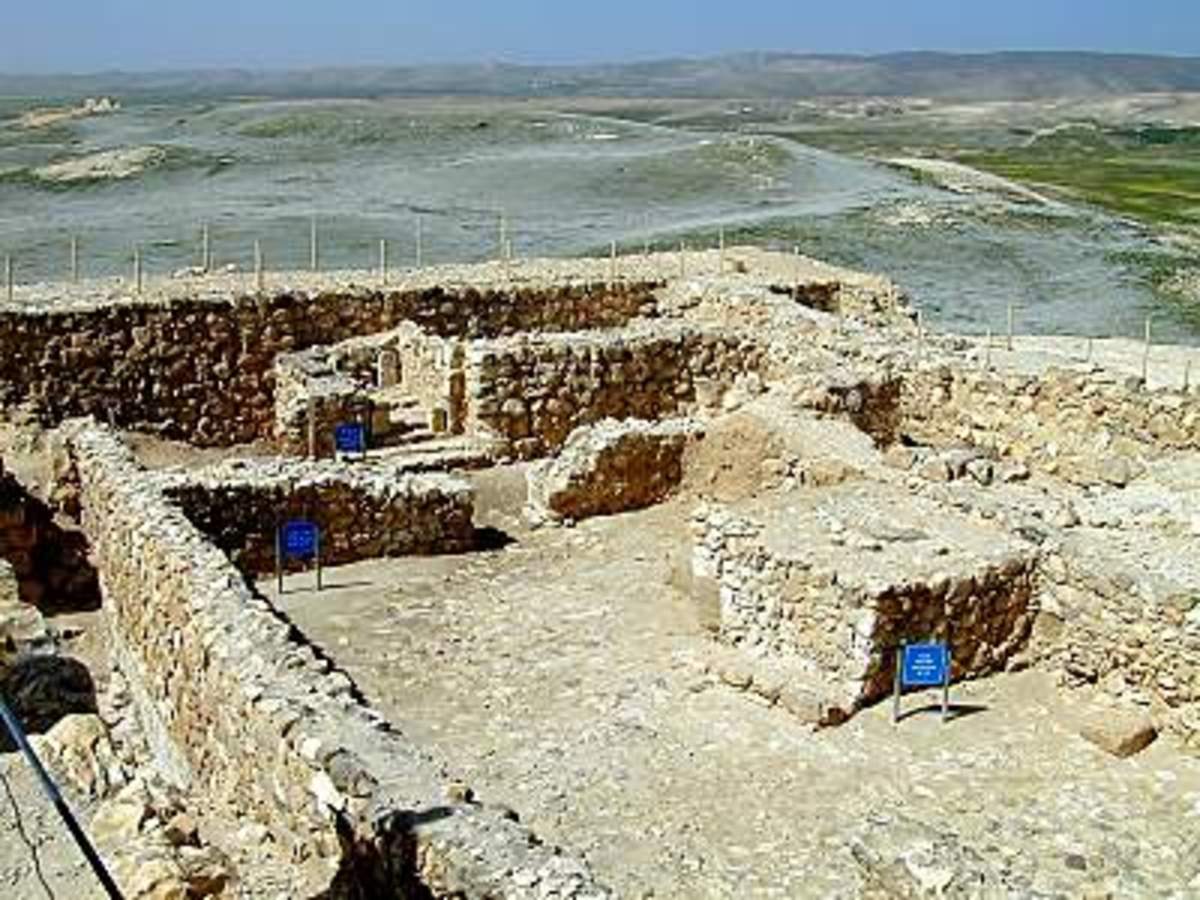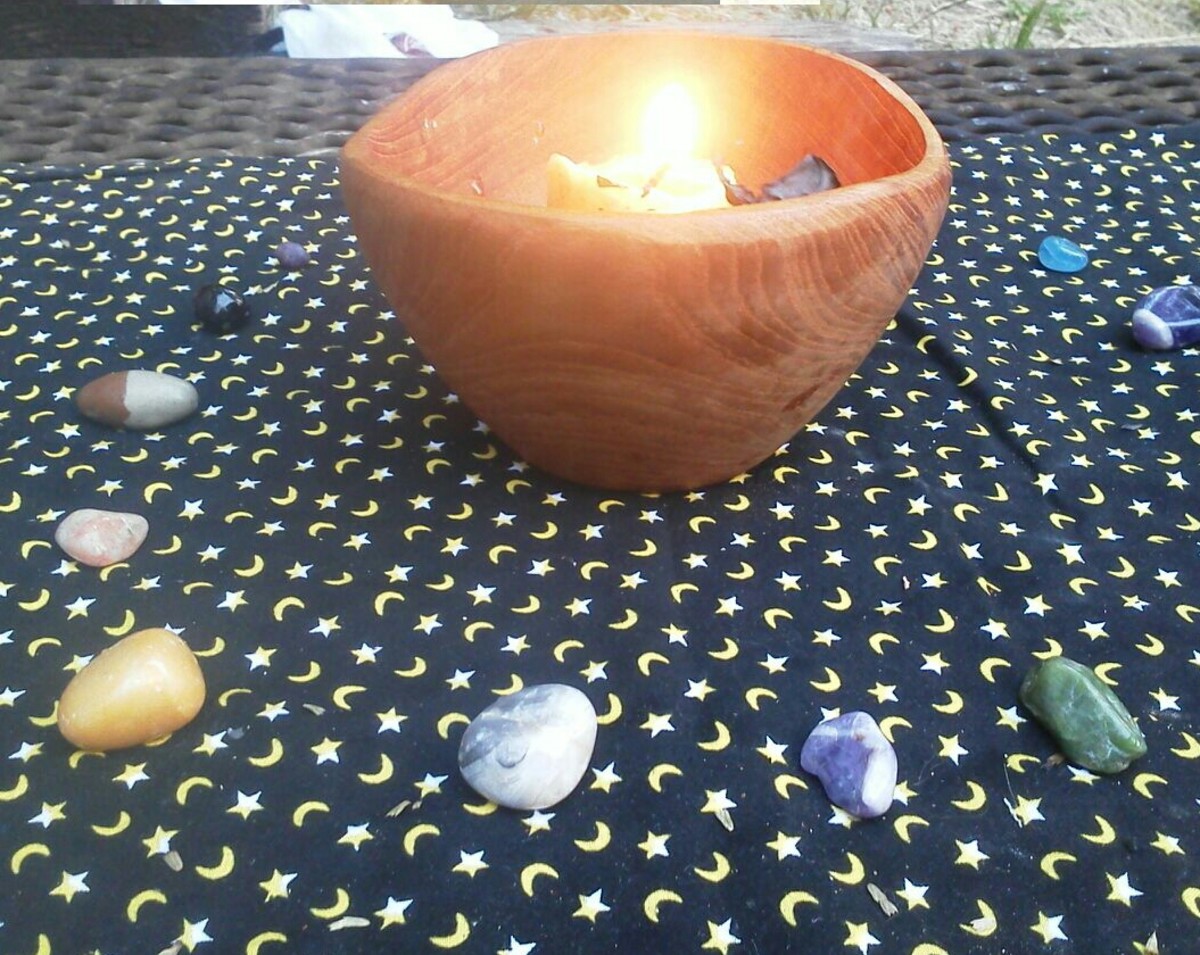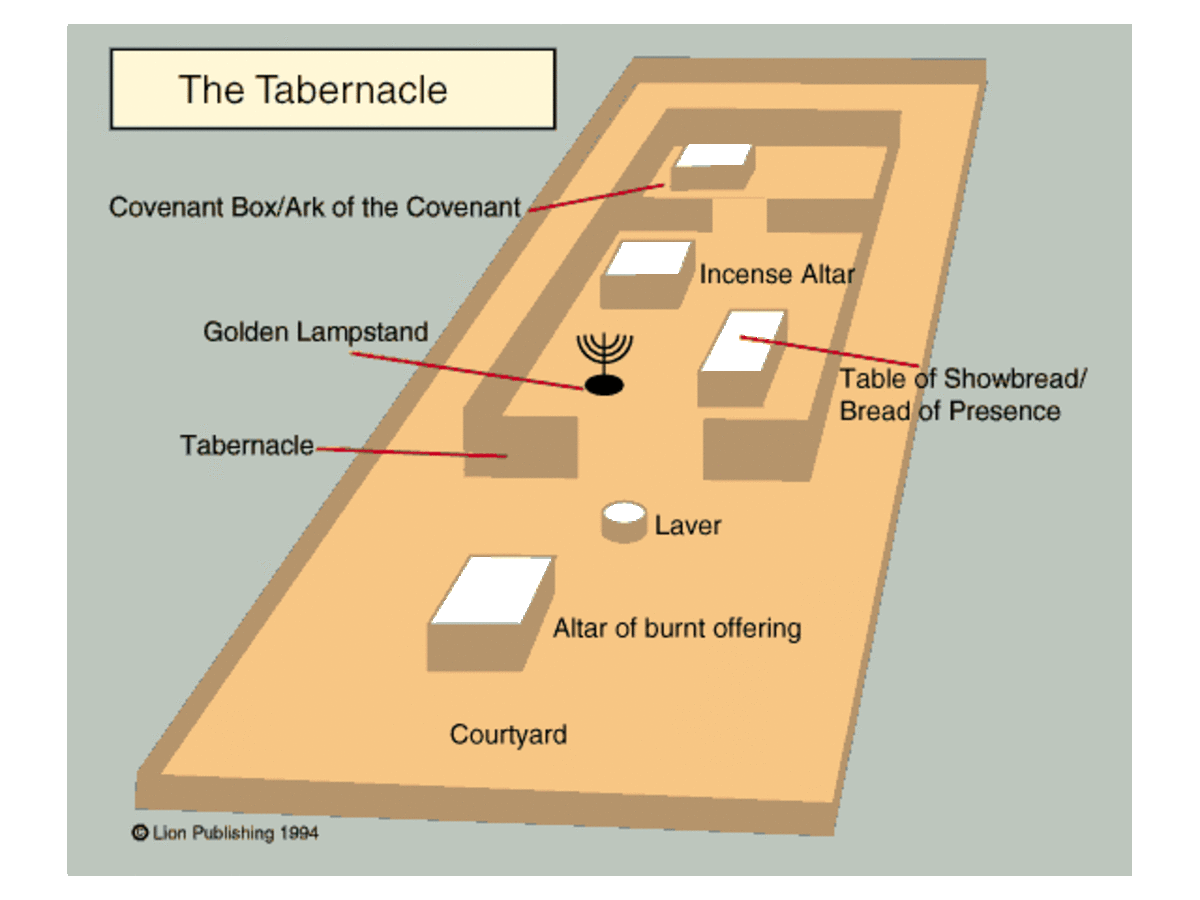Working to Create Your Altar: Wiccan, Pagan, Buddhist, or Any Other Place of Spirituality
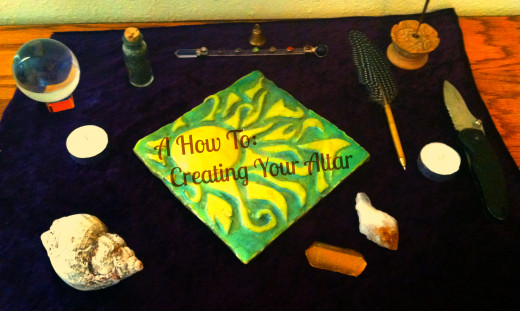
What Do You Mean, "Altar"?
An altar is a great many things to many people. Traditionally, it has religious connotations. It can be where the priest or father stands during church, it can be a place to pray, it can be a location to honor a person's life - whether it be their death, union, or birth. It can be a place of inspiration, a setting which on a subconscious level puts you in the mood.
Where Do I find An Altar?
An altar can be anywhere. At a wedding, I found the father stood before one at a Catholic church. I have seen shrines devoted to holy figures. On the day of the dead, photos of deceased are placed with candles all around.
Any one can find an altar anywhere if one looks hard enough. It is a place which offers comfort, honor, structure, prayer. It a place where tools are laid out for specific proceedings to acquire answers, or to set something in motion.
A court room could be considered an altar, a dancing ritual in which there is are duelistic sides, each person states their purpose, and the judge, with his own altar holds his tools to act as the Universe does, and make a call.
For a writer, their altar might be their computer, perhaps with an oil burner going, a cup of tea or coffee next to them, in their own sacred room, calling out to the creative energies of the Universe, to use him or her as a medium. Perhaps an altar is an easel, next to which paints are laid out on a table, beckoning to the artist to pour their heart onto the canvas.
Sometimes the altar is the kitchen, the green house, the spare room, the clearing in the woods, the make up counter, or in this case, that private little area where you begin your spiritual work.
Have you visited an altar?
A Brief History
As mentioned before, there are a great many backgrounds which include altars in their practices. You will find in many religions, altars were a place of sacrifice, whether it be people, animals, objects representing desire, or fruits for the deities to enjoy.
**Please take this time to note that this article is NOT about spaces in which to slaughter anything.**
Christian Altars - The Bible speaks of altars, referencing Cain and Able who brought offerings to their alter, or the people of Israel who made sacrifices on alters, in an effort of gaining forgiveness. "The killing of an animal was an object lesson that would make one's skin crawl, because death is a horrible sight. This was God's purpose, that the sinner would realize that he was the one who deserve to die, and yet a merciful God provided a sacrifice, a substitute, to stand in and receive the punishment of death on behalf of the sinner." ~Bible-History.com
Catholic Altars - The Confession booth is also considered an alter. It is a place where Catholics may release their sins to a man of God, who symbolized God's messenger, and receive forgiveness and answers. During earlier centuries, there were Basilicas, which were public buildings for the Romans, though were also used for religious ceremonies and gatherings, during which time, alterations were made. in some parts of the world, there was a War Alter. This was where Mass was celebrated before going to battle.
Jewish Altars - In Hebrew, the word "altar" means "A Place of Slaughter". The Rambam advises that once an altar is built, it is never to be moved. Thus, Jewish altars were built from stone. Mount Moriah, in fact, is not only considered an altar, but as is its entire site. These were said to be for sacrifice, as many stories in the Bible explain.
"Of the two Altars in the Temple, the golden one for the incense is said to symbolize the devotion of the soul, whose nourishment is of a finer nature; the bronze Altar for animal sacrifice, that of the body, which is fed on flesh" ~ Jewish Encyclopedia
Hindu Altars - Eastern religions also had a place of worship which contained an altar. A Hindu altar generally consists of depictions of a chosen God and Goddess, an oil lamp or more, and would have objects which the altar-keeper would offer to them (a puja tray). In temples, each deity would have their own shrine so that each could be worshiped.
Buddhist Altars - Generally set on a wooden cabinet with doors, Buddhist shrines have a depiction of the Buddha, and/or a mandala scroll. These items would be placed on the highest space of the cabinet as a show of honor. Candles, incense, bells, are placed on the altar, as well as a clear space or platform, which fruit may be offered. the altar, whether placed in the home or a temple, is a place of meditation.
Taoist Altars - These generally have objects which represent spirits, ancestors and/or deities. When "greeting" an alter, it is customary to be holding incense and bowing the head to the shrine. During certain times of the year, food is placed on or around the altar as an offering. Things were burned as a transition of an object from the living world to the spirit world, so that the departed would be able to take the item with them.
Pagan Altars - Norse Paganism utilized the altar as a place of sacrifice. The optimal building material was stone, though wood was found as well. The Druids would create their altars in groves, and often fire was a part of their practices, whether on or near the altar. Chalices, plants and staves were used for offerings from the Druids. In Wiccan practices, the altar generally holds a representation of a dualistic nature, an image of each element, as well as the tools for rituals including the athame, chalice, bells, and so on.
Egyptian Altars - Again, these altars were used for sacrifices to the Gods, though these were generally placed outside sanctuaries. If not for sacrifice, then altars were erected inside, though in some cases altars made their way into courts.
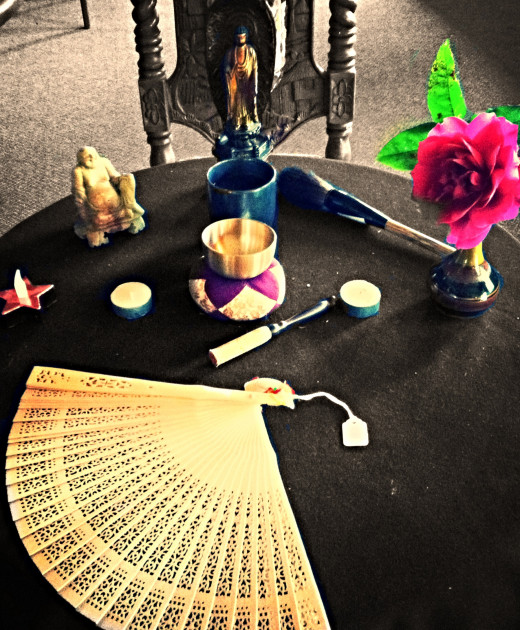
A Basic Alter
We will be exploring how to make a basic Altar. This is an altar which can be used for any purpose, for any religion, and something that can be (for the most part) easily packed away if need be.
First, you need to decide on your purpose for your Altar. Is it for meditation? Is it for prayer? Is it for inspiration? For Ritual?
For the purposes of this article, we are going to go for Ritual.
Collecting Your Altar Pieces
You will need:
- Representation of the dualistic nature of the Universe.
I know, it sounds like a bunch of hippie talk. However, the Universe and everything as we know it is compiled of two sides: positive and negative, male and female, light and dark, soft and hard, etc. Each thing has its opposite, though neither contains a truly negative aspect, they just simply are. One is to balance the other. Many go for a representation of a God and Goddess of their choice, one might go for something as simple as a white piece of paper and a black piece of paper. One could go for a live flower and a dried flower, or two candles. It is purely dependent on the altar-creator, and what jives well with you. - A bell, small gong, singing bowl, and/or white sage/sandalwood. This will be used to clear the area of unwanted, unseen guests. The gong or singing bowl may stay on the alter, warmed up and struck. A bell should be taken around the room and rung three times in each corner, dark crevice, as well as each direction (North, East, South, West), moving clockwise and starting in the East. Burning bundles of white sage or a stick of Sandalwood should be moved similarly throughout the room. If white sage is used, a snuffing plate should be on the altar as well.
- A representation of each of the elements, Earth, Air, Fire, and Water.
- A center Piece. This is what brings everything together for you. Many Pagan Altar-makers have a Pentagram which represents each element and the spirit and how they are all connected. Some may simply have a Yin-Yang symbolizing how one of the dualities cannot exist without the other. Perhaps it is a photo of your family which represents the center of the Universe to you.
- A table to assemble your altar on. This needn't be very big. The tallest you would want it would be waste height, but traditionally an alter is no more than two to two-and-a-half feet tall. Generally one might kneel before it, or meditate before it, at which point it is necessary to be able to get more than your nose above table level.
Elements and Some Correspondences
Earth
| Air
| Fire
| Water
|
|---|---|---|---|
North
| East
| South
| West
|
Green
| Yellow
| Red
| Blue
|
Dirt, Rocks, Plants, salt
| Feathers, Incense
| Candles, Incense
| Water
|
Winter
| Spring
| Summer
| Autumn
|
Coins
| Swords
| Staves/Wands
| Chalice/Cups
|
Each element has correspondences which represent them: Direction, Color, ritual representation, time of year, tarot suit, and many more.
Steps of Altar Building
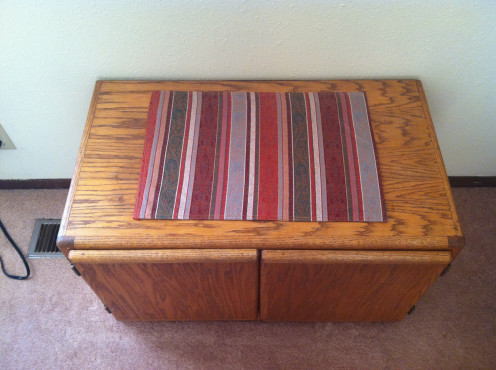
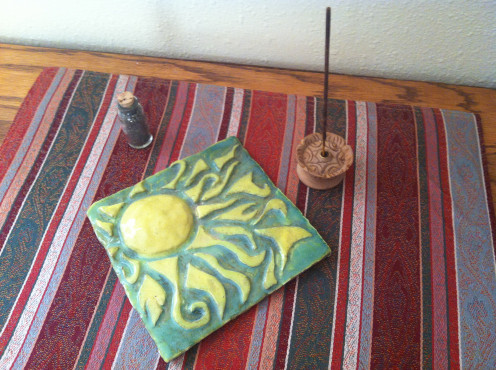
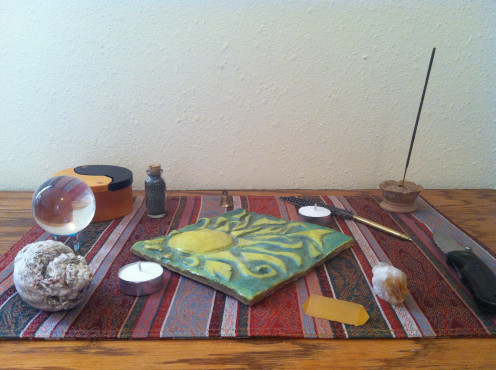
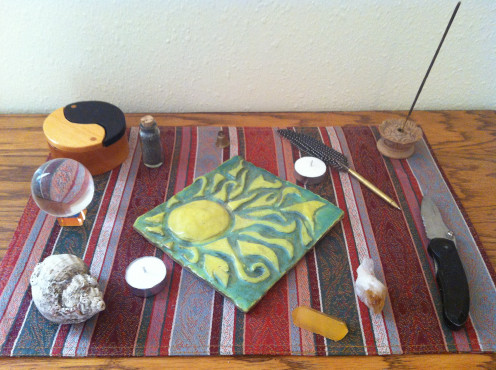

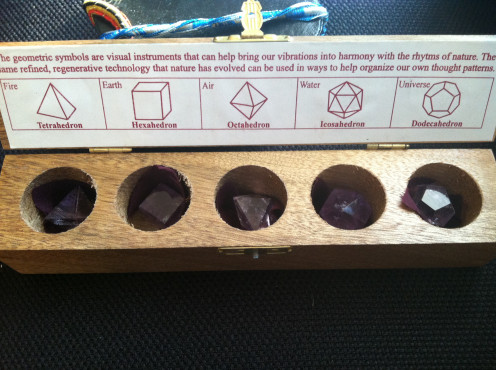
Assembling Your Alter
Be sure to keep your mind clear and focused. Let any worries or troubles drift away before you begin erecting your sacred space. You may find it beneficial to practice Preparation for Ritual techniques before assembling your altar.
The table is generally covered in a black, white, or purple cloth. These colors represent the spirit, the Universe, the thing which makes everything one. It is not necessary, but it does help with bringing in the mood, if nothing else.
Your altar should face east. East is where the sun rises and represents the beginning. you center piece should be the first to go onto the altar, then your dual representatives. When you begin laying out your elements, start with Air, and lay out each going clockwise.
As you lay out your altar, take a moment to reflect on what each piece means to you, how it represents you and your intentions. Ask yourself what you can learn from this piece, and what it conjures within you. It may be helpful to keep a journal with you to write down your thoughts as you do this, or a voice recorder.
References
- Chart of the Four Elements or Five Elements in Wicca - ReligionFacts
- Ancient Egyptian Temple Elements Part IV: The Sanctuary and its Environs
Ancient Egyptian Temple Elements Part IV: The Sanctuary and its Environs, Beyond the hypo style hall in smaller temples we might find the sanctuary, but in many instances there could be several other chambers or halls. - Altar (Wicca) - Wikipedia, the free encyclopedia
- Altar - Wikipedia, the free encyclopedia
- Altar (Catholicism) - Wikipedia, the free encyclopedia
- Basilica - Wikipedia, the free encyclopedia
- CATHOLIC ENCYCLOPEDIA: History of the Christian Altar
An elevated surface, tabular in form, on which the Sacrifice of the Mass is offered - ALTAR - JewishEncyclopedia.com
Complete contents the 1906 Jewish Encyclopedia. - The Site of the Altar: Revered Throughout History - Kabbalah, Chassidism and Jewish Mysticism

